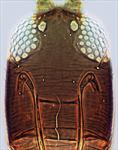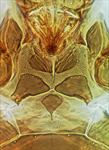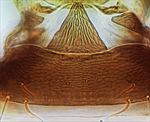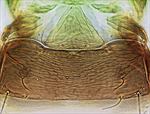
Female

Antenna

Head

Pronotum

Prosternum

Mesonotum & metanotum

Pelta & tergite II

Pelta & tergite II

Female segments IX–X (tube)

Fore wing
Both sexes fully winged. Body brown to dark brown; fore tarsi and inner apex of fore tibiae, also pedicel of antennal segment III yellowish; fore wing pale with extreme base shaded. Antennae 8-segmented, segment III short with one sense cone, IV with 4 sense cones; segment VIII short and broad at base. Head longer than wide; maxillary stylets one third of head width apart, retracted to postocular setae, maxillary bridge complete; postocular setae bluntly pointed, about half as long as eyes. Pronotum with three pairs of weakly capitate major setae, anteromarginal and midlateral setae no longer than discal setae; epimeral sutures complete; prosternal basantra and ferna large, mesopresternum eroded to paired lateral triangles. Fore tarsal tooth prominent and recurved at inner apex of tarsus. Fore wing with about 10 duplicated cilia, sub-basal setae S1 and S2 blunt to weakly capitate, S3 acute. Tergite IX setae S1 bluntly pointed, shorter than tube, S2 acute.
Male with broadly based fore tarsal tooth; pronotal midlateral setae well-developed; sternite VIII without pore plate; tergite IX setae S2 short and stout; pseudovirga of aedeagus slender.
In California, the only species similar to H. halophilus is H. ruber (Moulton), but that is known only from a single female that has capitate rather than pointed postocular setae (Cott, 1956). The genus Haplothrips, one of the three most species rich genera of Thysanoptera, and currently includes about 245 species worldwide (Mound & Minaei, 2007). These species are found mainly from Europe across the Old World, and only a few come from South America (Mound & Zapater, 2003). Although 17 Haplothrips species are listed from Mexico and North America (Mound & Marullo, 1996) only six of these are recorded from California (Hoddle et al. 2004). Little is known of the biology of the Californian species, although elsewhere the species of Haplothrips are associated particularly with the flowers of Poaceae and Asteraceae.
Presumably breeding in flowers, and possibly of Poaceae as most available specimens were swept from grasses.
Widespread in Western USA, and reported from Utah, Arizona, New Mexico, Texas and California.
PHLAEOTHRIPIDAE, PHLAEOTHRIPINAE
Haplothrips halophilus Hood
Haplothrips halophilus Hood, 1915: 29
Cott HE (1956) Systematics of the suborder Tubulifera (Thysanoptera) in California. University of California, Berkeley, Publications in Entomology 13: 1–216.
Hoddle M, Mound LA & Nakahara S (2004) Thysanoptera recorded from California, USA: a checklist. Florida Entomologist 87: 317–323.
Mound LA & Marullo R (1996) The Thrips of Central and South America: An Introduction. Memoirs on Entomology, International 6: 1–488.
Mound LA & Minaei K (2007) Australian insects of the Haplothrips lineage (Thysanoptera – Phlaeothripinae). Journal of Natural History 41: 2919–2978.
Mound LA & Zapater MC (2001)South American Haplothrips species (Thysanoptera, Phlaeothripidae), with a new species of biological control interest to Australia against weedy Heliotropium amplexicaule (Boraginaceae). Neotropical Entomology 32: 437–442.